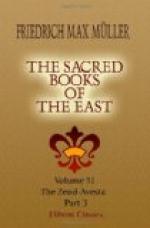There are twenty-nine chapters of the “Koran,” which begin with certain letters of the alphabet: some with a single one, others with more. These letters the Mohammedans believe to be the peculiar marks of the “Koran,” and to conceal several profound mysteries, the certain understanding of which, the more intelligent confess, has not been communicated to any mortal, their prophet only excepted. Notwithstanding which, some will take the liberty of guessing at their meaning by that species of Cabbala called by the Jews, Notarikon, and suppose the letters to stand for as many words expressing the names and attributes of God, his works, ordinances, and decrees; and therefore these mysterious letters, as well as the verses themselves, seem in the “Koran” to be called signs. Others explain the intent of these letters from their nature or organ, or else from their value in numbers, according to another species of the Jewish Cabbala called Gematria; the uncertainty of these conjectures sufficiently appears from their disagreement. Thus, for example, five chapters, one of which is the second, begin with the letters A.L.M., which some imagine to stand for Allah latif magid—“God is gracious and to be glorified”—or, Ana li minni—“to me and from me”—belongs all perfection, and proceeds all good; or else for Ana Allah alam—“I am the most wise God”—taking the first letter to mark the beginning of the first word, the second the middle of the second word, and the third the last of the third word: or for “Allah, Gabriel, Mohammed,” the author, revealer, and preacher of the “Koran.” Others say that as the letter A belongs to the lower part of the throat, the first of the organs of speech; L to the palate, the middle organ: and M to the lips, which are the last organs; so these letters signify that God is the beginning, middle, and end, or ought to be praised in the beginning, middle, and end of all our words and actions; or, as the total value of those three letters in numbers is seventy-one, they signify that in the space of so many years, the religion preached in the “Koran” should be fully established. The conjecture of a learned Christian is, at least, as certain as any of the former, who supposes those letters were set there by the amanuensis, for Amar li Mohammed—“at the command of Mohammed”—as the five letters prefixed to the nineteenth chapter seem to be there written by a Jewish scribe, for Cob yaas—“thus he commanded.”
The general contents of the “Koran” may be divided under three heads: First, precepts and laws in matters of religion, such as prayer, fasting, pilgrimage; there are laws also given in the affairs of the civil life, such as marriage, the possession and bequeathing of property, and the administration of justice. The second division would include histories, which consist in a great part of incidents from the Bible, as Christians know it. Mohammed probably picked up a good deal of hearsay knowledge




